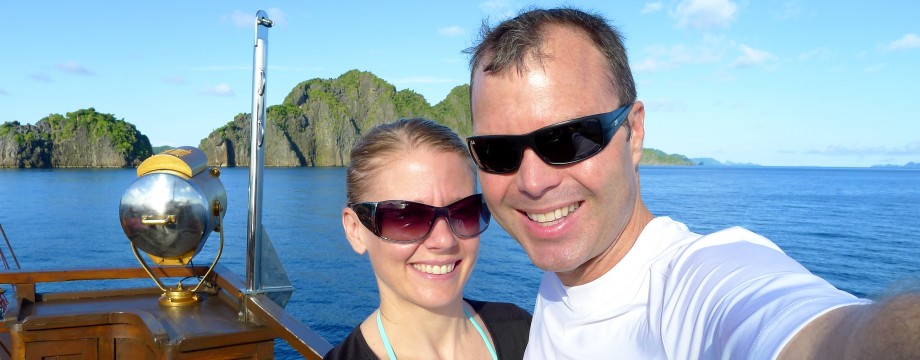Today we woke up and had a small breakfast at Terra Cotta (the hotel restaurant) before heading out for cycling. Our cycling tour guide, Joe (Ketut) from Bali Eco Tours picked us up at the hotel and we were on our way up the mountain to have breakfast and start our cycling tour. Part way up the mountain, we stopped and took a few photos of some great views of a rice plantation.
It was quite foggy today up on the mountain. You can’t see it but Mt. Batur is behind the fog above the lake.
Before getting to our bicycles, Ketut took us to their Balinese plantation, where we learned of medicinal and cultural uses of all the plants, the spices and we can’t forget, the Coffee Luwak (Kopi Luwak). Let me give you a brief overview of what Coffee Luwak is. This coffee is the most unusually produced and most expensive coffee in the world. The coffee is produced by a cat. The beans are taken from the coffee berries once they have been eaten and excreted by the Asian Palm Civet. See the cat below. Ted was brave enough to give it a try. It was quite expensive at $6US per cup (small cup).
Here, you can see them roasting the coffee beans.
The Asian Palm Civet.
The coffee that Ted tried. We also were able to taste many other Balinese coffee and teas.
After stopping at the plantation, we were on our way to get the bicycles. We got fitted for bikes and helmets and headed out for our tour. We spent the next couple hours trekking across parts of Bali that most visitors don’t get the opportunity to see. Ketut took us through small villages where the children yell “hello, hello, hello” to you as you pass by. Some of the kids jump out and want a high-five as you pass by.
Ketut took us to a small village and we were able to meet the family and tour their home. Here is the grandma of the village. We were told that she does not know how old she is. Loved getting this close up photo of her. You can just see the blood and sweat in this woman’s face.
Some of the family members making the underside of a thatched roof out of bamboo. This will be sold for about $20US once complete.
The village kitchen
These cows are their bread and butter. They don’t make very much off of them.
Once we were on our way again, we stopped at a plantation where we were able to see a farmer planting rice. Each of the minimal green rice sprouts is planted by hand, leaning over and placing a small young sprig of rice plant into the submerged soil, moving step by step through the thick mud, across paddies containing thousands of acres of rice. There may be 10,000 plants in a single paddy. Yikes!
We were told by friends that previously lived in Bali if we were ever visiting when there was a cremation, it is a true cultural experience. It is truly a special site to see and the locals welcome you to the celebration. A brief overview of a Balinese cremation. The cremation season begins in the third week of August and concludes by the end of the month. The previously buried corpses, including those buried up to five years ago, have to be dug up and placed in a temporary shrine in the cemetery for cremation. As you can see in the third picture below, you will see the white cloths. This is where the bones are transferred up into the shrines where they will then be burned.
The traditional Balinese dress for a cremation ceremony.
Here is just some of the bones of the corpses. Many of families are very poor and a cremation is very expensive so they hold cremation ceremonies in groups in order to economize. A Balinese cremation is a big event and much of it has nothing to do with the physical aspects of the dead body, it is the spiritual that is of much greater importance.
Here are more of the shrines where the bones will be transferred to for the cremation.
Offerings provide symbolic pleasure to the ancestors and to the spirits that will be shortly released to God. Most importantly, the offerings will implore God to purify the spirit and return it to earth in an appropriately higher and purer form. These women must walk around the shrines three times before giving their offerings.
The cremation ceremony was a great thing to see. The ceremony can go on for a whole day. We continued on as we trekked through more small villages and rice plantations. We concluded our ride with an amazing Balinese lunch provided by Bali Eco Tours.
Here is a little video of our tour:
We got back to the hotel and we were told that Bliss Spa was the place to go for a massage. We took a walk and guess where we ended up…. Bliss Spa. It was so worth the $12.50US for a one hour full body massage. It was AMAZING.





















